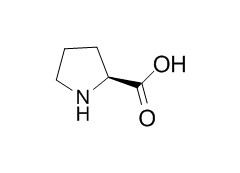Natural Products
Proline
| Catalog No. | CFN99612 |  |
| CAS No. | 147-85-3 | |
| Molecular Weight: | 115.1 | |
| Molecular Formula | C5H9NO2 | |
| DBs | [PubChem]:274950541 [ChEMBL]:17203 [PCIDB]: |
Standard InChI:
InChI=1S/C5H9NO2/c7-5(8)4-2-1-3-6-4/h4,6H,1-3H2,(H,7,8)/t4-/m0/s1
Biological Activity
Proline accumulates in many plant species in response to environmental stress, it can act as a signaling molecule to modulate mitochondrial functions, influence cell proliferation or cell death and trigger specific gene expression, which can be essential for plant recovery from stress, the engineering of proline metabolism could lead to new opportunities to improve plant tolerance of environmental stresses.[1]
Elicitor- and wound-induced oxidative cross-linking of a proline-rich plant cell wall protein, which is a novel, rapid defense response.[2]
Proline isomerization as a novel noncovalent histone modification that regulates transcription and provides evidence for crosstalk between histone lysine methylation and proline isomerization.[3]
Human pVHL binds to a short HIF-derived peptide when a conserved proline residue at the core of this peptide is hydroxylated, because proline hydroxylation requires molecular oxygen and Fe 2+ , this protein modification may play a key role in mammalian oxygen sensing.[4]
Product
References
[1] Szabados L, Savouré A. Trends Plant Sci, 2010, 15(2):89-97.
[2] Bradley D J, Kjellbom P, Lamb C J. Cell, 1992, 70(1):21-30.
[3] Nelson C J, Santos-Rosa H, Kouzarides T. Cell, 2006, 126(5):905-16.
[4] Ivan M, Kondo K, Yang H, et al. Science, 2001, 292(5516):464-8.
[5] Rusconi L, Perseo G, Franzoi L, et al. J Chromatogr A, 1985, 349(349):117-30.
Product Use Citation





